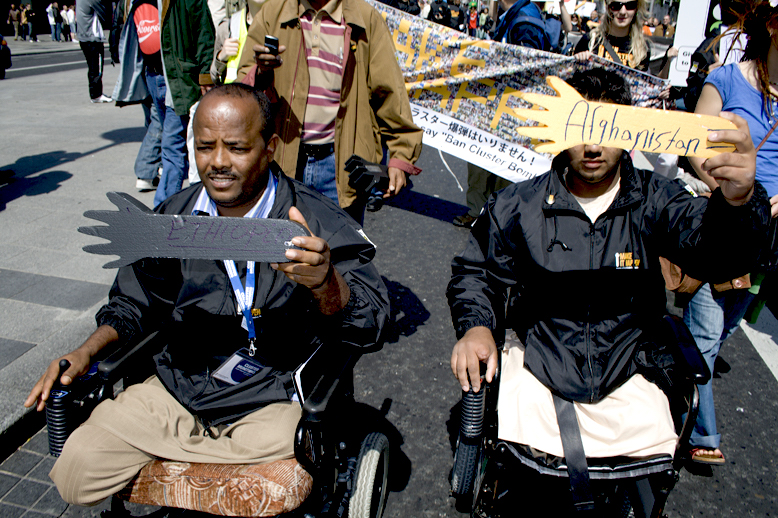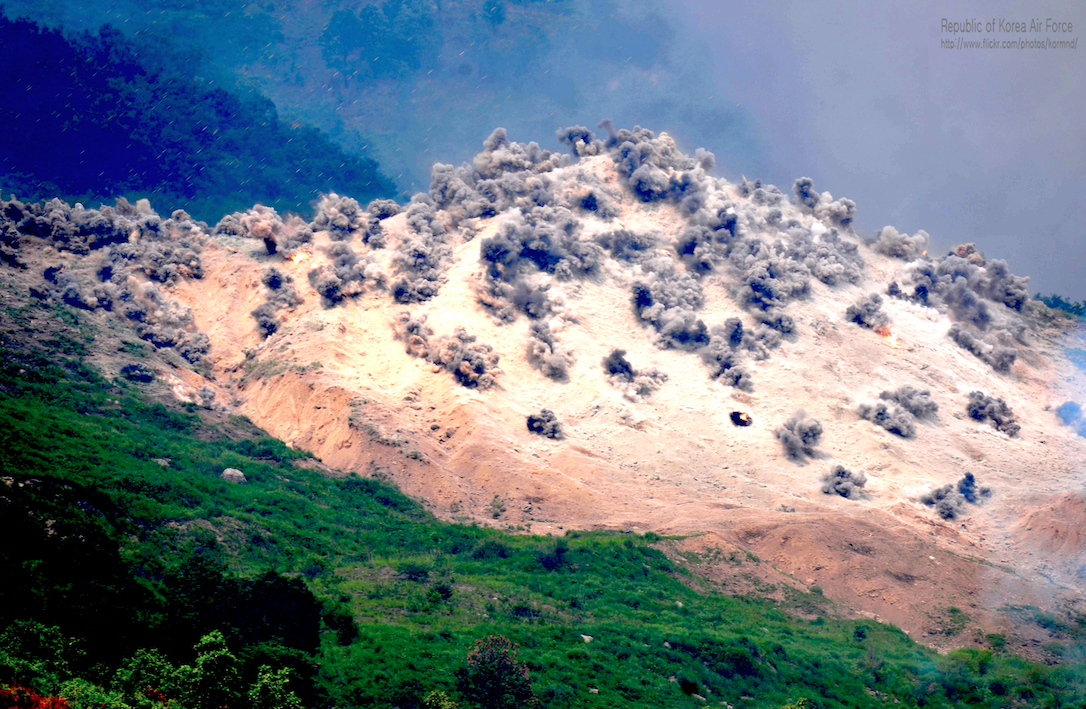U.S. cluster munitions have maimed and killed civilians in countries including Laos, Vietnam, Cambodia, Afghanistan and Iraq, even years after the wars have ended, Abdul Rahman reports.

Demonstrators at the May 2008 Dublin Diplomatic Conference on Cluster Munitions that produced the Convention on Cluster Munitions. (pxkls, Wikimedia Commons, CC BY-SA 2.0)
By Abdul Rahman
Peoples Dispatch
 The sad quip about “NATO fighting against Russia to the last Ukrainian” once again proved apt when U.S. President Joe Biden took the “difficult” decision earlier this month to supply cluster munitions to Ukraine to facilitate its fight against the Russians.
The sad quip about “NATO fighting against Russia to the last Ukrainian” once again proved apt when U.S. President Joe Biden took the “difficult” decision earlier this month to supply cluster munitions to Ukraine to facilitate its fight against the Russians.
The supply of cluster munitions is a part of a fresh $800 million military aid package to Ukraine, which came on the eve of the NATO summit at Vilnius in Lithuania, which was attended by Ukrainian President Volodymyr Zelensky.
The dangerous nature of cluster munitions, especially for civilians, is well known. Close to 120 countries signed a convention in 2008 against their production and use.
In the present case, the decision is more dangerous for Ukrainians for two specific reasons — first, it provides Russians with a perfect justification to retaliate with far superior force, and second, the battlefields where the munitions will be used are primarily inside Ukraine.
Long-Term Impact
A cluster munition is a bomb containing multiple sub-munitions. They are dropped from air or fired from the ground and explode mid-air to release tens, sometimes hundreds, of sub-munitions which spread across an area equal to several football fields, with no distinction between military and civilian areas.
The sub-munitions explode with impact as they fall on the ground. However, a large number of them fail to explode due to the way in which they fall and become hazardous like landmines, exploding sometimes days or years after they were originally released.
Given the large dud rates — anywhere between 2 percent and 40 percent — it is most likely that whoever wins the war will have a herculean task in cleaning up the unexploded munitions to prevent a large number of civilian casualties due to accidental explosions.
This can be understood from the examples of Laos and Cambodia. Nearly 20 million tons of cluster munitions were dropped by the U.S. in Laos, of which 30 percent remained unexploded.
At least 20,000 people in Laos, half of them children, have either died or been injured since 1975 due to explosions caused by unexploded bombs dropped by the U.S. Clearing unexploded cluster bombs is more difficult as it is relatively harder to locate them.
Yet Another U-Turn

Biden in 2021. (DoD/Lisa Ferdinando)
The decision to supply cluster munitions is yet another U-turn in the Biden administration’s Ukraine policy, which had expressed doubts just a few months earlier, claiming that they were too dangerous.
This is now a pattern for the Biden administration — first denying a crucial weapon citing possibilities of dangerous escalation with Russia, but later going ahead with the supply or asking allies with the same set of weapons to do so.
U.S. and other NATO members have followed this pattern in the supply of the Patriot missile defense systems, HIMARS rocket launchers, battle tanks and fighter jets to Ukraine.
[Last week the U.S. House of Representatives voted down an amendment to prohibit the transfer of cluster bombs to Ukraine.]
When asked by journalists why the decision to send cluster bombs was approved now, Biden made a passing remark that Ukraine had run out of conventional munitions. This took place amid the so-called Ukrainian counteroffensive which was much celebrated by NATO and the Western media.
The U.S. is, by far, the largest user of cluster munitions in the world. It has used these weapons indiscriminately in Vietnam, Laos, Cambodia, Afghanistan, and Iraq. Israel, a close U.S. ally, used cluster bombs in Lebanon in 2006.
Notably, the use of cluster bombs in Iraq and Afghanistan came years after the ill effects of their use in Laos and Cambodia became clear and the world was already discussing a convention to ban them.
Civilian Victims

A cluster bomb is dropped at the Nightmare Range in South Korea, 2012. (Republic of Korea Armed Forces, Wikimedia Commons, CC BY-SA 2.0)
There are already reports about Ukraine’s widespread use of cluster bombs against Russians in the current war and. Cluster bombs were also reportedly used by Ukraine against its own citizens during the initial phases of the Donbass resistance in 2014.
However, following an outcry in the media, it declared that it will not use the bombs received from the U.S. in Russia, which means that they will be used in Russian-controlled regions in Ukraine.
Ukraine anyway has limited or no capacity to drop the bombs deep inside Russian territories.
While saying that Russia has deliberately refrained so far from using cluster munitions in Ukraine given the threat to the civilian population, Russian Defense Minister Sergei Shoigu recently claimed that, “if the U.S. supplies cluster munitions to Ukraine, the Russian armed forces will be forced to use similar means of destruction against the Ukrainian armed forces as a retaliatory measure.” [Human Rights Watch said in May that Russia has already used cluster bombs, as has Ukraine.]
The civilians in Donbass or Crimea are perhaps going to face the impact of the current war for generations thanks to the Biden administration.
Abdul Rahman is a correspondent for Peoples Dispatch.
This article is from Peoples Dispatch.
The views expressed are solely those of the author and may or may not reflect those of Consortium News.


Sick American s***.
I see that Republican senator Tom Cotton backs Biden on cluster bombs to the Ukraine.
What further evidence is needed that this is the wrong decision?
We can assume that the Ukrainians will use what weapons they are granted until they cannot. We know the following:
1. Ukraine has made many disingenuous and inaccurate statements about what it did and did not do in this conflict
2. Ukrainian dependence on NATO suggests that they will continue to lie for PR reasons–understandably, really.
3. The Ukrainian government itself is deeply dependent on NATO support for its own integrity, as it has been since the coup in ’14
4. NATO–and specifically Boris Johnson, likely sent by the US–disallowed a peace agreement early in the post-invasion conflict.
5. Anyone analyzing combat with access to Ukrainian information must know that Ukraine has no chance to “win” this war in one form or the other.
6. Russia retains no confidence in Western assurances, which have just been lies.
7. Russia has little interest in governing Ukraine, particularly Western Ukraine, past what it calls “de-Nazification”–basically, pulling the Nazis and other belligerent and anti-Russian elements that are NATO allies out of power.
At this point, it is hard to imagine that this does not mean slaughtering most of the power bloc in western Ukraine, presumably including any military forces it assembles.
From the point of view of a Ukrainian of any sort of political belief, “war of attrition” comes dangerously close to “war of elimination,” since Western leaders apparently see no reason to preserve Ukrainians, and Russia has little other way to be assured that they will not be armed with nuclear missiles, and considerable motive to not compromise about that particular matter.
What would Diana, princes of Wales would say about the cluster bombs?
Biden really is a nasty piece of work. A Trump with greasy manners.